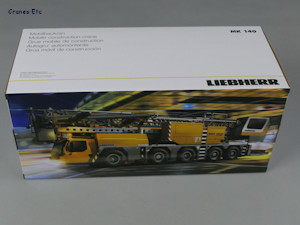 |
| Liebherr style box.
|
 |
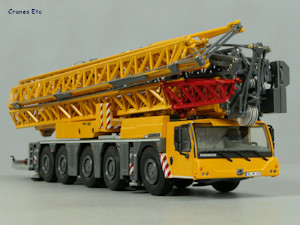 |
| Very impressive. |
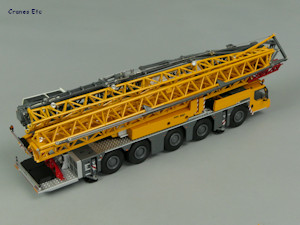 |
| Carrying extra
counterweight on board. It is road legal in Cranes Etc land. |
|
|
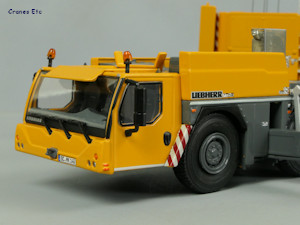 |
| Smart looking cab. |
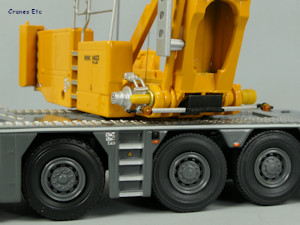 |
| Nice wheels. |
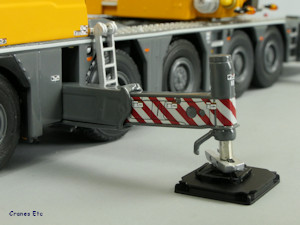 |
| Very detailed outrigger
beams. Not quite straight under load. |
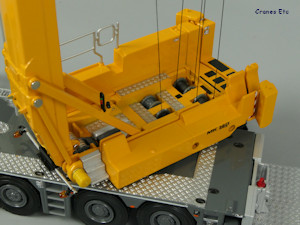 |
| All winches are
modlled.
|
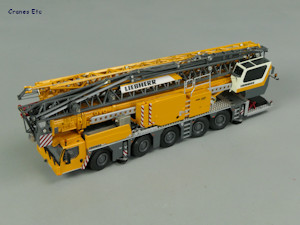 |
| Looks great. |
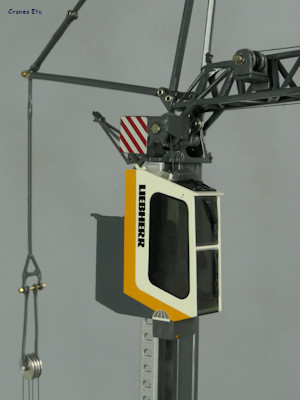 |
| Detailed cab. |
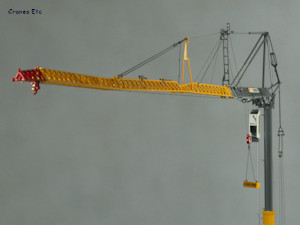 |
| A very good profile can
be achieved. |
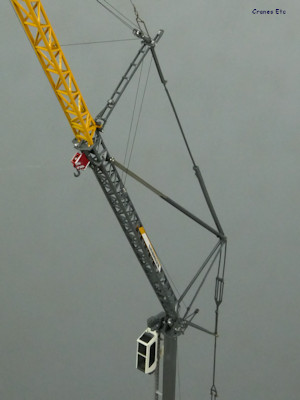 |
| Trolley parked when
using full luffing mode. |
|

The Liebherr
MK 140 Mobile Construction Crane
is a 5 axle machine with a maximum lifting capacity of 8 tonnes.
Depending on configuration it can lift almost 2 tonnes at the
maximum radius of 65m. The jib can be angled up to 70° to
give a maximum lifting height of 94m.
Packaging
The model comes in a Liebherr branded box and inside it is packed within
expanded polystyrene trays. Although the model is
secured to the bottom tray with twist ties, they are
soft and easy to remove.
The review model had no
defects or missing parts.
A 24 page manual provides some information about the
real machine. It has an illustrated parts list and many
colour photos describe the assembly.
There are many parts to fit, and it is a complex piece of
model engineering. It is well made but care needs to be taken not to force any
parts during erection, or more particularly when folding it up.
To display the model properly in transport mode it has
to be fully built up and rigged first, and then folded
up.
Detail
The
underside of the carrier is very detailed with the
steering, suspension and transmission parts all modelled. The tyres
have a decent tread pattern. The wheels are
different on driven and non-driven axles.
The driving
cab has a cable protection guard on the roof and twin beacon
lights.
The lights are finely detailed and there is a number
plate. The interior detail is very good too.
Behind the cab the engine area is highly detailed with
excellent mesh grilles. Diamond plated surfaces
are used elsewhere, and there are two folding access
ladders. A highlight is the many tiny warning
graphics. The tool carrier at the back is fitted
with a detailed metal light bar.
The outriggers have metal beams with smooth faced
pistons. There is excellent graphics detailing on the
beams and posts. Four plastic spreader plates are
included.
The crane body
continues the high standard of detailing
and the lines of the body are only broken by small access holes
for the key to turn the winches. A metal handrail has to
be fitted. All winches are modelled, including the
tower raising winch although it is not reeved.
At the tower base there is a spooling drum for the
control cables to run to the cab, although it is empty
and would have looked nice with some rope on. A
pin is used to lock the tower upright, although it is
off colour compared to the rest of the model.
The ballast is provided as three separate parts and they
have sharp graphics.
The tower is a three stage telescopic structure. It continues
the high level of detailing with intricate pipework modelled. There is a metal ladder rail section
attached to the lower part and the two sections above are fitted
by hand when the tower is extended as having the rail telescope
was probably too great a modelling challenge in this scale.
At the top of the tower is the cab winch and this
connects to the cab which is a good looking part with a
detailed interior just visible through the tinted
windows.
The jib is metal throughout and
the manual states that for the first time in a model
like this it is modelled in aluminium to reduce weight
compared to diecast metal. It is fully
triangulated and also has the work lights detailed.
The jib is mechanically complex. The assembly
ropes, cables and ties are made to tight tolerances to
enable a good looking jib profile which was very good on
the review model. It was possible to adjust it
slightly to improve the profile further. Small
metal pulleys are used throughout.
The trolley is plastic, and both it and the metal hook
for it have tiny
metal pulleys. A single line metal hook is also included
for use in full luffing mode. The hoist rope tying
off point and luffing mode pulley is a plastic part
which can be clipped on at various locations on the jib.
A Liebherr flag advertising the VarioJib function is provided as a load to hang
from the hook in luffing mode. A solid metal Liebherr-branded
load block is also included.
Features
The carrier has independent steering on each axle so all
modes of steering can be reproduced and the range of
movement
is good. Each axle has sprung suspension.
The outriggers can be deployed and are strong enough to support
the weight of the model when erected, although movement in the
beam joints means they are not perfectly straight under
load.
The ladders to the carrier deck can be unfolded.
Variable counterweight configurations are possible and the
full counterweight helps to improve stability of the model.
It is possible to pose the crane as if undergoing the phases of
erection although this cannot be carried out by operating the winches
alone as various hand manipulations are required. When the
crane is erect it is stable, but the lifting capacity at long radius
is limited.
A key is supplied to operate the various winches.
The cab
can be raised and lowered up and down the mast.
The jib can
be unfolded and either posed horizontal or luffed at an angle
just like the real crane. Extra jib sections
enable the crane to have a full luffing mode with a 70
degree angle, and when displayed like this the model is
nearly 2m tall.
The hook can be raised
and lowered, but particular care is required to maintain the
hoist rope on the winch drum. It easily runs off
the side of the drum and gets snagged which is difficult
to fix. If the model is only to be obtained and
displayed in the erected condition then the arrangements
work. But if it is intended to display the model
in transport mode or use the hoist function than
replacing the hoist rope with something with less
stiffness is strongly recommended.
The trolley has
to be positioned by hand. However, the trolley winch is provided
and there is some rope wound on it, and some of the
pulleys needed for the trolley function are modelled.
The winch for raising the tower and the pulleys for that
function are modelled. A skilled modeller may be
able to reeve it up in an acceptable fashion.
Quality
This is a high quality technically complex model and so
some parts are delicate, but there is limited use of
plastic.
The paintwork is very good and the graphics are
excellent.
Price
It is good value given the complexity and size.
Overall
It is great to see Liebherr
have invested in getting a model of the very complex MK
140 manufactured, and WSI have produced a very nice,
highly detailed model. It is not really a model for a beginner, but time spent with it
is rewarded with an outstanding model.
Footnotes
The model first appeared at the BAUMA exhibition in April 2019,
and became generally available in October of that year.
|
|
|
|
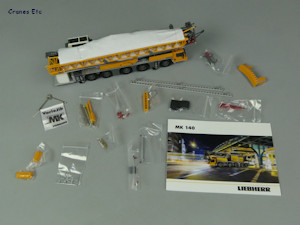 |
| The many parts and
manual out of the
box.
|
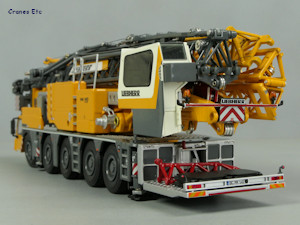 |
| Storage platform at the
rear. |
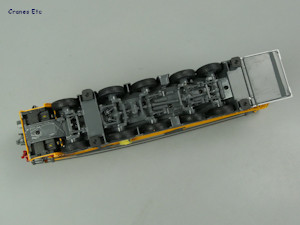 |
| Detailed undercarriage.
|
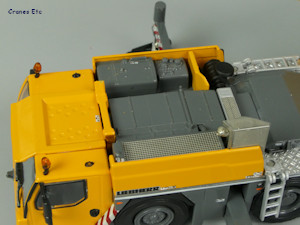 |
| High detail around the
carrier engine. |
|
|
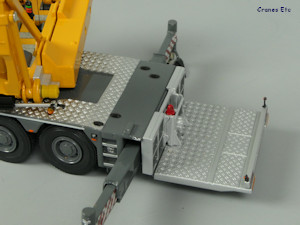 |
| Big equipment carrier. |
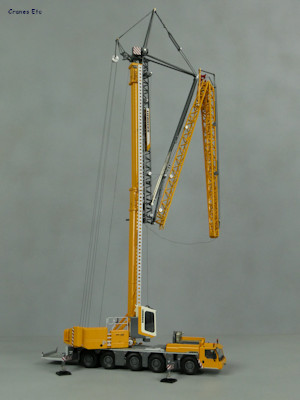 |
| Erection poses can be
simulated. |
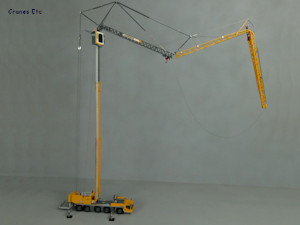 |
| Unfolding. |
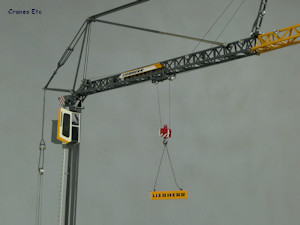 |
| Load block on the hook. |
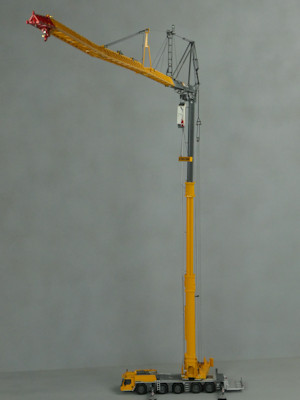 |
| Fully erected in trolley
mode. |
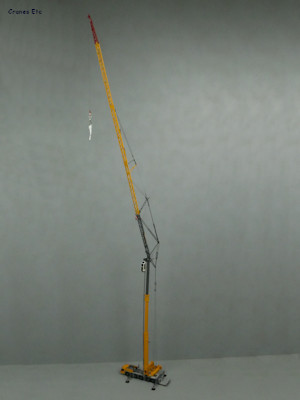 |
| Fully erect it is over
2m tall. |
|

